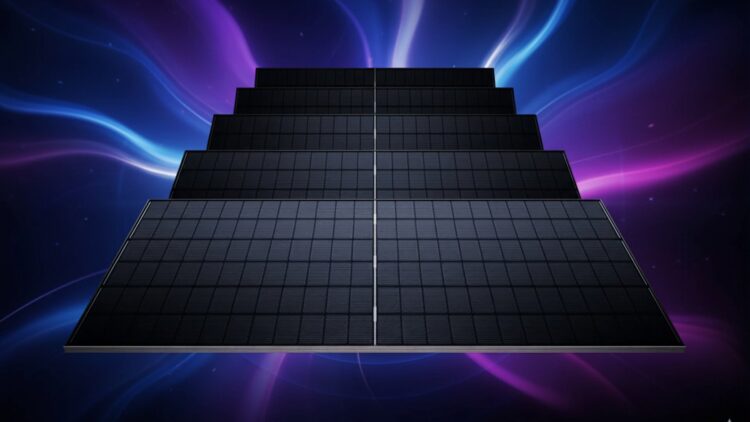Double-sided 580W bifacial solar module, designed not just for power, but for real-world performance.It promises to change everything we know about vertical installations and agrivoltaic projects, where energy meets agriculture. It’s no surprise that with this double-sided technology, the company is capturing more energy from the back of the module while maintaining all the reliability expected of solar energy solutions. But how exactly does this new technology work?
Double the sun, double the power: the rise of bifacial solar panels
All this thanks to AE Solar. And you might be wondering: what makes these panels stand out? The new CMD-L144BD model, part of the Terra series, utilizes TOPCon (n-type tunnel oxide passivated contact) technology, which increases panel efficiency. This design allows it to capture more energy from both direct sunlight and light reflected from the ground, walls, or surrounding surfaces.
In fact, one of the most impressive features of this panel is the power gain of up to 10% it offers on the back. This is a significant leap forward compared to conventional panels, where energy capture is limited to the front of the module. The additional bifaciality means the panel generates more electricity, making it a highly attractive option for large-scale installations that require high levels of energy production.
Built to last, designed to lead: why terra panels redefine solar power
We also need to highlight what makes the Terra series panels so special. It all starts with each panel being composed of 144 half-cells, with a design that improves panel efficiency and reliability. These half-cells reduce the panel’s overall resistance, allowing for better performance even in low-light conditions. Panel efficiency ranges from 20.62% to 21.36%, which is considered high for solar modules. This means that AE Solar’s bifacial panels not only capture more energy from both sides, but also convert that energy into usable electricity more efficiently than many other options on the market.
Not stopping there, with an anodized aluminum frame and a 2mm glass cover, these panels are built to last. In other words, they’re weatherproof, operating in temperatures ranging from -40°C to 85°C, making them suitable for a wide range of climates (which even reminds us of that other invention: the first typhoon turbine), from freezing winters to hot summers. And what does all this mean in practical terms? Let’s break it down:
- Higher efficiency: With a maximum power output of 580W and bifacial technology, these modules are ready to generate more energy than traditional solar panels.
- Cost-effective: The ability to capture more energy leads to a lower levelized cost of energy (LCOE), meaning the long-term cost of generating energy is significantly reduced.
- Versatility: The ability to work in vertical installations and agrivoltaic systems makes these modules ideal for a wide range of projects, from agricultural solar farms to urban rooftops.
- Sustainability: As more industries seek green energy solutions, AE Solar’s bifacial panels offer a sustainable and cost-effective way to generate solar power.
Leading the charge: how AE solar’s 580w panels are shaping the next energy revolution
As the world shifts toward renewable energy sources, products like AE Solar’s 580W bifacial panel are leading the way in transforming the solar industry. The technology behind these panels offers the best of both worlds:
- More power and greater efficiency.
- Without compromising durability or cost-effectiveness.
With these innovative modules, AE Solar is positioning itself at the forefront of the solar revolution, meeting the growing demand for sustainable energy and the need for space-efficient solar solutions. The company’s strategic focus on vertical installations and agrivoltaic projects demonstrates how adaptable this technology can be to solve the challenges of today’s energy landscape. Another invention that has also been attracting attention is this first-ever solar flower.
Disclaimer: Our coverage of events affecting companies is purely informative and descriptive. Under no circumstances does it seek to promote an opinion or create a trend, nor can it be taken as investment advice or a recommendation of any kind.


